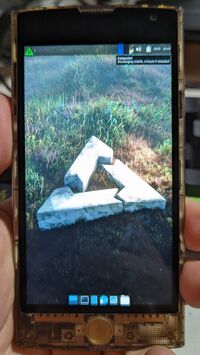LG Fx0 (lg-madai)
 LG Fx0 running Xfce4 | |
| Manufacturer | LG |
|---|---|
| Name | Fx0 |
| Codename | lg-madai |
| Model | LGL25 |
| Released | 2014 |
| Type | handset |
| Hardware | |
| Chipset | Qualcomm Snapdragon 400 (MSM8926) |
| CPU | 4x ARM Cortex-A7 |
| GPU | Adreno 305 |
| Display | 720x1280 TFT |
| Storage | 16 GB |
| Memory | 1.5 GB |
| Architecture | armv7 |
| Software | |
| Original software | Firefox OS |
| Original version | 2.0 |
| FOSS bootloader | no |
| postmarketOS | |
| Category | testing |
| Pre-built images | no |
| postmarketOS kernel | 3.4.0 |
| Flashing |
Works |
|---|---|
| USB Networking |
Works |
| Internal storage |
No data |
| SD card |
No data |
| Battery |
Works |
| Screen |
Works |
| Touchscreen |
Works |
| Multimedia | |
| 3D Acceleration |
No data |
| Audio |
No data |
| Camera |
No data |
| Camera Flash |
No data |
| Connectivity | |
| WiFi |
Partial |
| Bluetooth |
No data |
| GPS |
No data |
| NFC |
No data |
| Modem | |
| Calls |
No data |
| SMS |
No data |
| Mobile data |
No data |
| Miscellaneous | |
| FDE |
No data |
| USB OTG |
No data |
| Sensors | |
| Accelerometer |
No data |
| Magnetometer |
No data |
| Ambient Light |
No data |
| Proximity |
No data |
| Hall Effect |
No data |
| Haptics |
No data |
| Barometer |
No data |
LG Fx0, also known as LGL25, is a smartphone manufactured by LG Electronics. Fx0 was originally available only in Japan, sold by KDDI. The hardware is similar to LG G2 mini (lg-g2m) while Firefox OS is installed instead of Android.
There are two known versions of Fx0. The original, SIM-locked and non-rooted version was available from the official sales channel. Later, the SIM-free and rooted version appeared in aftermarket. The rooted (SIM-free) version is strongly recommended if you try postmarketOS on Fx0.
Contributors
- peremen
Users owning this device
- MasanoriOgino (Notes: 2x)
How to enter flash mode
| The LG download mode is disabled by default. See the Installation section below for enabling it. |
To enter the LG download mode, unplug the device from the USB, power off, and hold while connecting to the USB [1]. You will see the DOWNLOAD MODE line if succeeded.
Note that the LG download mode may fail to flash. lk2nd 19.0 or later will work with Fx0 and provides stability, a better UI and more features. Press while booting to enter fastboot mode if lk2nd is installed. Alternatively, you can flash with netcat instead.
Installation
You need to erase the LAF partition to enable the LG download mode. Given that there is no kdz or tot file for this device available, it does not make sense to keep laf for flashing.
# Backup your LAF partition - on adb shell su dd if=/dev/block/platform/msm_sdcc.1/by-name/laf of=/sdcard/laf.img dd if=/dev/zero of=/dev/block/platform/msm_sdcc.1/by-name/laf # On the host adb pull /sdcard/laf.img
There are three partitions: system (1 GiB ext4, mmcblk0p35), userdata (4 GiB ext4, mmcblk0p37), and sdcard (~8.5 GiB vfat, mmcblk0p38). Do not ZERO out the userdata partition, as this partition contains some firmware files (audio and Wi-Fi) customized to the device.
Components
- UART: According to service manual UART is provided as a part of JTAG connector, unpopulated by default and only accessible after opening the case. The Pin 14 (lower right, bigger pad than others) is MSM_UART_TX, which needs to be hooked up to the RX of the UART adapter.
- Wi-Fi: Qualcomm WCNSS. Note that the LG source code archive lacks the prima driver, which is used in Firefox OS. According to
dmesgin Firefox OS, it is version v3.2.3.172. Porting the prima driver from LineageOS kernel makes Wi-Fi work, but it seems that NetworkManager seems not like this configuration. - Display: no backlight adjustment yet, also had to change the visual to RGB565 to get a working Xfce4.
- Given the sorry quality and lower version of stock LG kernel, maybe mainlining could be worth?
See also
- Device package
- Kernel package
- Kernel source (mirrored from LG OSS Center when it was alive)